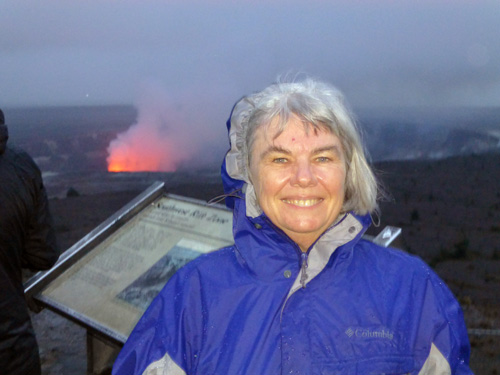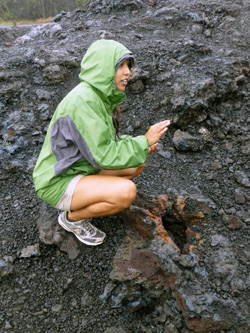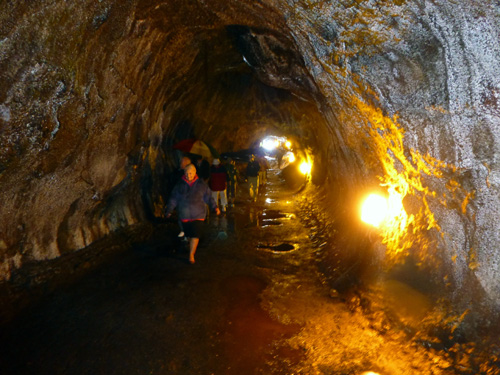
San Diego Jewish World editor Donald H. Harrison recently returned from a round-trip cruise between San Diego and Hawaii. This is the fifth article in a series about that trip.
By Donald H. Harrison
VOLCANOES NATIONAL PARK, Hawaii — As our van wended its way from the berth of Holland America Line’s Zaandam in Hilo to the visitor’s center at the Kilauea Volcano, our gregarious guide, Nohe, explained the origin of the ubiquitous word “aloha.”
In the Hawaiian language, “alo” means “share,” whereas “ha” is “the breath of life,” she said. Put them together, and “aloha” means “to share the breath of life.” Nohe (No-hay) added that “when ancient Hawaiians would greet each other, they would wrap one hand around each other’s neck” and touch the area in the middle of each other’s foreheads — the so-called third eye — and then they would inhale, thereby taking in each other’s presences or breaths of life.

One may extrapolate that “to share the breath of life” is an act of great intimacy, an act of love. “My family has taught me that a lifestyle of ‘aloha’ is a lifestyle of love, courtesy and gratitude,” Nohe confided. “I try to approach every relationship, even conflict, with that in my heart.”
I was pondering this gentle philosophy as we approached the fiery and smoky Halema’uma’u crater which could be seen clearly from the visitors center located more than a mile from the crater which is nested inside the Kilauea caldera.
At first glance, the smoke, sulfur dioxide and lava of Kilauea may seem just the opposite of the “breath of life,” in that it is noxious to humans.
However, the ancient Hawaiians believed that Pele, goddess of thunder, lightning and volcanoes, resided in the Halema’uma’u crater, and that whenever there was an eruption, the passionate goddess was expressing her longing for a missing, and obviously non-human, lover.
Pele’s burning love is a legend, but if we examine the record over the last 30 years, we might posit an alternative legend. We could suggest that the noise and smoke from the crater at Kilauea’s summit are the cries of agony from Pele’s mouth and that the deity has been laboring in the process of giving birth to new Hawaiian lands. In these three decades, the shore line of Hawaii has grown by some 500 acres as a result of the aggregation of lava that has flown into the sea from Pu’u O’o, an area on a slope of Kilauea located between Halema’uma’u and the Pacific Ocean. It is as if Pu’u O’o is Pele’s womb, and the new land mass her child.
Believing Jews, of course, see the work not of Pele but of the One True God in fashioning this miracle. Skeptics, on the other hand, may attribute all this to geologic momentum, the result not of divine design but of naturally occurring forces. Whatever position one takes in this ages-old debate, there is no denying that the power of volcanoes and their ability to noisily reshape the landscape are awe-inspiring. Whoever or whatever is at work at Kilauea certainly demonstrates what Nohe calls the “aloha” spirit. The breath of life–for a new land–is being generously shared.

To learn more about how volcanoes work, one may wander through the Jaggar Museum near the lip of the caldera, or simply go to the multimedia page of the website of Volcanoes National Park, (http://www.nps.gov/havo/photosmultimedia/index.htm) to enjoy a variety of well-presented videos on the subject.
As good as these videos are, they do not stimulate the same sense of wonder that one feels when one approaches Halema’uma’u Crater, especially at night when the flames fingerpaint the skies in red hues. Nor do the videos provide the tactile sensation of walking across a field pitted and charcoal blackened by a lava flow, nor the sense of adventure that accompanies walking inside a hollow lava tube several football fields long, through which Halema’uma’u’s molten passion once coursed.
Unless “smell-a-vision” someday is routinely offered through the Internet, the videos can’t replicate the aromas of flowers and plants of the tropical rain forest one walks through en route to the Thurston Lava Tube, nor the acrid smell of volcano steam venting from small cavities near Kilauea’s mysterious summit.
*
Harrison is editor of San Diego Jewish World. He may be contacted at donald.harrison@sdjewishworld.com